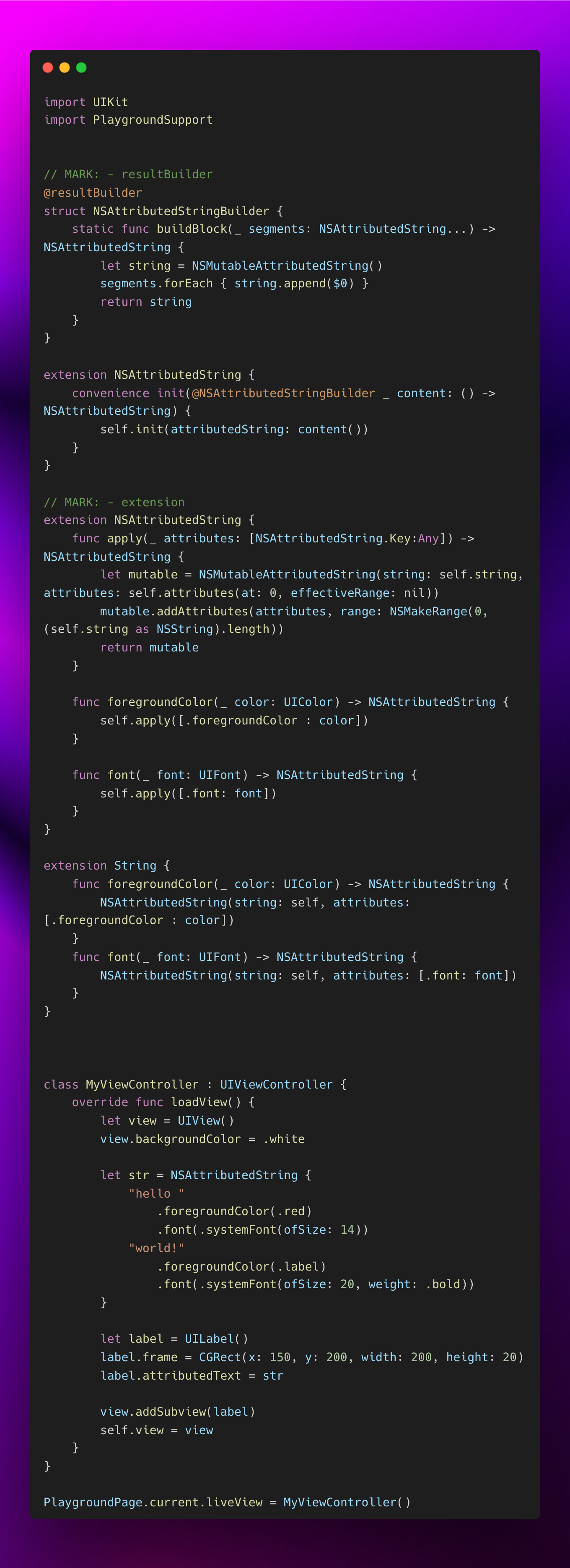官方文档:
什么是 result builder?
Result builder 是一种声明属性,用来修饰类,结构体,枚举,利用它可以使 swift 实现嵌入领域特定语言 DSL (Domain Specific Language)。
DSL 没有计算和执行的概念,和命令式编程不同,使用的时候只需要声明规则,事实以及某些元素之间的层级和关系。我们使用 swift 和 UIKit 编写应用程序,一直以来都是命令式编程,直到 swiftUI 出现。
实际上我们已经多次接触过声明式语法,例如目前苹果推崇的 swiftUI 以及 cocopods 的 podfile 文件:
struct ContentView: View {
var body: some View {
// This is inside a result builder
VStack {
Text("Hello World!") // VStack and Text are 'build blocks'
}
}
}
SwiftUI 的声明式语法就是通过 result builder 来实现的。如果我们查看 SwiftUI View 协议的声明,我们可以看到@ViewBuilder 属性定义的 body 变量:
@ViewBuilder var body: Self.Body { get }
ViewBuilder 就是使用 result builder 修饰之后实现的一个自定义构造器。
🎣 ResultBuilder 之前的名字是 functionbuilder,所以如果看到例如
@functionBuilder或@_functionBuilder,本质是同一个东西。
自定义一个 result builder
从实践出发,我们可以自己尝试着实现一个简单的例子来学习。NSAttributedString 就是一个很好的例子,构建富文本是一件比较痛苦的事情,如果可以使用 swiftUI 的声明式语法,那不是很快乐?比如说像这样:
NSAttributedString {
"Hello "
.color(.red)
"World"
.color(.blue)
.underline(.blue)
}
那让我们一步步来开始尝试使用 @resultBuilder。
一、创建一个函数构造器
@resultBuilder
struct AttributedStringBuilder {
static func buildBlock(_ segments: NSAttributedString...) -> NSAttributedString {
let string = NSMutableAttributedString()
segments.forEach { string.append($0) }
return string
}
}
首先使用 @resultBuilder 属性标注一个结构体,然后我们必须要实现上面的这个方法,这个方法的含义是你想要如何通过 block 传递进来的数据构造 NSAttributedString。传递进来的是一个或者多个 NSAttributedString ,我们通过遍历拼接之后返回。
OK,我们已经完成了最重要的一步。
二、创建一个方便的初始化器
extension NSAttributedString {
convenience init(@AttributedStringBuilder _ content: () -> NSAttributedString) {
self.init(attributedString: content())
}
}
我们可以简单理解为AttributedStringBuilder结构体已经变成了一个简单的函数,使用的时候用 @AttributedStringBuilder 来修饰,在闭包中返回一个或者多个 NSAttributedString,生成一个拼接好的 NSAttributedString。
为了让我们使用起来更加的方便,我们给 NSAttributedString和 string 加上几个扩展方法,在使用字符串创建的时候更简洁。
// MARK: - extension
extension NSAttributedString {
func apply(_ attributes: [NSAttributedString.Key:Any]) -> NSAttributedString {
let mutable = NSMutableAttributedString(string: self.string, attributes: self.attributes(at: 0, effectiveRange: nil))
mutable.addAttributes(attributes, range: NSMakeRange(0, (self.string as NSString).length))
return mutable
}
func foregroundColor(_ color: UIColor) -> NSAttributedString {
self.apply([.foregroundColor : color])
}
func font(_ font: UIFont) -> NSAttributedString {
self.apply([.font: font])
}
}
extension String {
func foregroundColor(_ color: UIColor) -> NSAttributedString {
NSAttributedString(string: self, attributes: [.foregroundColor : color])
}
func font(_ font: UIFont) -> NSAttributedString {
NSAttributedString(string: self, attributes: [.font: font])
}
}
三、大功告成
到这里已经全部完成了,让我们来试试我们的声明式富文本构造器。
let str = NSAttributedString {
"hello "
.foregroundColor(.red)
.font(.systemFont(ofSize: 14))
"world!"
.foregroundColor(.label)
.font(.systemFont(ofSize: 20, weight: .bold))
}

以上其实已经实现了我们想要的效果,在其之上我们再扩展一些经常使用到的属性,就可以很方便的创建 NSAttributedString了,在 github 中的https://github.com/ethanhuang13/NSAttributedStringBuilder仓库就是使用的 @resultBuilder,其核心就是步骤一中的代码。
**除此以外,****@resultBuilder**还有一些可选的实现方法,来完善构造器,例如我们如果返回一个可选值,该如何处理?如果想要像 swiftUI 一样支持 if-else,switch,该如何处理?
这些也很简单,在官方文档中,我们可以看到还有很多构建方法,用来解决不同类型,不同数据的处理:
// 对应 block 中没有值返回的情况
static func buildBlock(_ components: Component...) -> Component
// 通过一个或多个值来构建 必须实现
static func buildBlock(_ components: Component...) -> Component
Combines an array of partial results into a single partial result. A result builder must implement this method.
// 通过可选值来构建,可以支持不包含 else 的 if 语句
static func buildOptional(_ component: Component?) -> Component
Builds a partial result from a partial result that can be nil. Implement this method to support if statements that don’t include an else clause.
// 支持通过条件来变化的值,通过下面这两个方法支持包含 switch 和 if-else 的语句
static func buildEither(first: Component) -> Component
Builds a partial result whose value varies depending on some condition. Implement both this method and buildEither(second:) to support switch statements and if statements that include an else clause.
static func buildEither(second: Component) -> Component
Builds a partial result whose value varies depending on some condition. Implement both this method and buildEither(first:) to support switch statements and if statements that include an else clause.
// 通过数组来构建 可以支持 forin 语句
static func buildArray(_ components: [Component]) -> Component
Builds a partial result from an array of partial results. Implement this method to support for loops.
// 通过 Expression 来生成,Expression 为自定义的表达式 具体可以看官方文档中的例子
static func buildExpression(_ expression: Expression) -> Component
Builds a partial result from an expression. You can implement this method to perform preprocessing—for example, converting expressions to an internal type—or to provide additional information for type inference at use sites.
// 用于对最外层的 `buildBlock` 结果的再包装。例如,让结果构建器隐藏一些它并不想对外的类型(转换成可对外的类型)。
static func buildFinalResult(_ component: Component) -> FinalResult
Builds a final result from a partial result. You can implement this method as part of a result builder that uses a different type for partial and final results, or to perform other postprocessing on a result before returning it.
// 如果提供了 `buildLimitedAvailability` 的实现,构建器提供了对 API 可用性检查(如 `if #available(..)`)的支持。
static func buildLimitedAvailability(_ component: Component) -> Component
Builds a partial result that propagates or erases type information outside a compiler-control statement that performs an availability check. You can use this to erase type information that varies between the conditional branches.
这些方法分别对应内部不同的元素来构建的时候需要做的操作,构建器在转译时会自动选择对应的方法。
总结
以上,我们可以看到 resultBuilder 其实很简单,同时也非常强大,通过 resultBuilder 我们可以简化非常多的代码,甚至可以自己实现一个在 UIKit 框架下 swiftUI 式的声明式构建方式,具体该如何使用,取决于你的 idea💡。
**想知道使用 result builder 可以干些什么有意思的事情吗?**可以在下面这个仓库中看看。
这篇文章希望能让你对 ResultBuilder 有一定的了解,更深入的学习推荐肘子的文章:
附本篇文章中的Demo代码:

